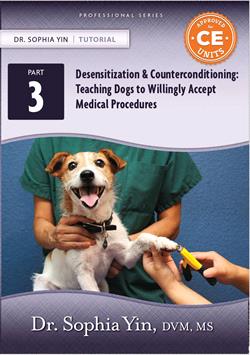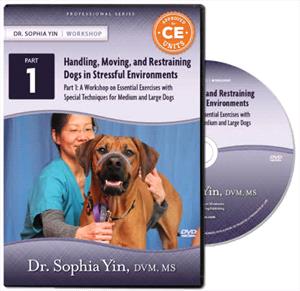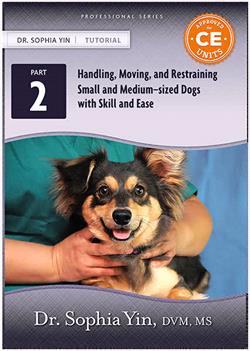NEW DVD! Desensitization and Counterconditioning: Teaching Dogs to Willingly Accept Medical Procedures
Dr. Sophia Yin’s passion was helping people understand animal behavior in an effort to bring people and their pets closer. She envisioned her Low Stress Handling techniques becoming the standard of care for anyone who works with animals. Her commitment to helping people communicate with their pets in a positive and scientifically sound way led her to create a suite of Low Stress Handling labs focused on the critical skills required to improve animal training and the experiences they have in medical procedures. This most recent release is the linchpin of training for anyone who wants to help resolve behaviorial problems in the examination or treatment room.
Desensitization and Counterconditioning: Handling, Moving & Restraining Part 3
Geared towards helping animals to not just tolerate handling and procedures, but to help them enjoy being cared for, the final lab in this series goes into detail on how to teach all dogs to enjoy being handled, restrained, or experience a procedure using Counterconditioning and Desensitization (DS/CC). Dr. Yin works with you on step–by–step methods to change the underlying fears that can affect patients. This DVD will enhance any learning library with its in depth coverage of counterconditioning. With clearly explained techniques you’ll see how to change the negative associations animals have to positive ones, so pets have good experiences in many situations. The techniques are demonstrated on dogs and cats; however, this application of behavior modification can be applied to many types of animals in many types of situations.
You’ll learn how to desensitize and countercondition dogs to the following:
- Putting on and wearing a muzzle/gentle leader.
- Being still while accepting injections.
- Being physically restrained and positioned.
- Receiving toenail trims.
- Sitting for jugular venipuncture.
What is the Master Collection?
With the addition of Desensitization and Counterconditioning, Dr. Yin completes her training series. We call the entire group of DVDs The Master Class Collection.
The complete master class collection starts with Handling, Moving & Restraining Dogs in Stressful Environments: HMR Part 1, which contains Labs 1 & 2, workshops on leash handling and walking techniques – also some large dog handling.
Your education continues in Handling, Moving & Restraining Small and Medium-sized Dogs with Skill and Ease: HMR Part 2, where you learn in Lab 3 specific Low Stress Handling methods for exams, blood draws and how to move through position changes.
Finally, the series concludes in Desensitization and Counterconditioning: Training Dogs to Willingly Accept Medical Procedures: HMR Part 3. In this final workshop, Lab 4, we move beyond handling itself and learn how to actually address the underlying reasons why pets are afraid of handling or procedures.
Handling, Moving and Restraining Part 1:
Lab #1 – Exercises specific to moving medium and large dogs from place to place. How to control movement in large and medium dogs, that may be aggressive or fearful due to being in a stressful environment. Whether they’re at the veterinary hospital, groomer or anywhere aside from home they may be experiencing stress. The techniques in this lab were designed to help you make your patients calm and comfortable in any stressful environment. You’ll gain the skills needed to guide them from place to place, use leashes properly so your patients understand your direction, and use your body language to impliment these skills.
Items covered include:
- Using your body language to guide dogs from place to place.
- The importance of walking speed when leading.
- Learn how to provide clear direction.
- Learn important leash holding techniques that keep you and your patients safe.
- Specific techniques for turns and stopping when moving from place to place.
Lab #2 – Here we’ve taken the underlying concepts of handling and guiding animals in stressful settings and applied them to creating specific techniques for controlling movement for procedures. In this lab we illustrate specific holds and techniques for handling medium and large dogs for a variety of procedures including blood draws, other sample collection, and exams. Armed with these tools, you’ll see a change in your patients; from fearful and resistant, to comfortable and cooperating with you.
Topics include:
- Getting into position for a variety of exams and procedures.
- Specific holds and techniques that apply to the comfort and body size of large and medium dogs.
- How to guide dogs into the position you need including: standing, sitting, down and lateral.
- Methods for blood draw for large and medium-sized dogs.
- Instruction and tips on moving through position changes; for example, from standing to lateral, standing to sitting, and sitting to down.
Handling, Moving and Restraining Part 2:
Lab #3 – Exercises for handling, moving, and restraining with particular techniques for small dogs.
In this lab we cover:
- Holds and techniques for controlling movement on the exam table.
- A review of the body language of fear and anxiety.
- Proper approach to holding and picking up small dogs, including modification for difficult, fearful or aggressive small dogs.
- Procedure for transferring small dogs from one person to another.
- Positions and position changes and handling for procedures specific to small dogs.
Get CE Units and Free Discussion Questions
All of Dr. Yin’s DVD/online courses are approved by RACE, CCPDT, and IAABC for required CE credits. Learn more, take CE tests, and get your credits here.





